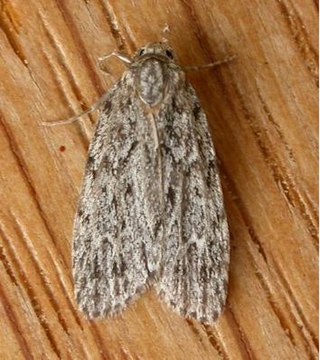
Halone is a genus of moths in the subfamily Arctiinae from southern Asia and Australia. The genus was erected by Francis Walker in 1854.

Termessa diplographa is a moth of the subfamily Arctiinae first described by Alfred Jefferis Turner in 1899. It is found in Eastern Australia, often inhabiting forested and open woodlands, as well as heathland habitats. As a lichen moth, the larvae of Termessa diplographa likely feed on lichens that grow on tree trunks.
Teratopora is a genus of moths in the family Erebidae.

Niceteria is a monotypic moth genus in the family Geometridae erected by Alfred Jefferis Turner in 1929. Its only species, Niceteria macrocosma, the showy geometrid, is found in Australia. It was first described by Oswald Bertram Lower in 1899.

Opodiphthera is a genus of moths from the family Saturniidae that are endemic to Australia.

Lichenaula is a genus of Australian moth of the family Xyloryctidae.

Xyloryctidae is a family of moths contained within the superfamily Gelechioidea described by Edward Meyrick in 1890. Most genera are found in the Indo-Australian region. While many of these moths are tiny, some members of the family grow to a wingspan of up to 66 mm, making them giants among the micromoths.
Gymnasura saginaea is a moth of the subfamily Arctiinae. It was described by Alfred Jefferis Turner in 1899. It is found in Queensland, Australia.

Hemonia micrommata is a moth of the family Erebidae. It was described by Alfred Jefferis Turner in 1899. It is found in northern Australia.
Philenora placochrysa is a moth in the subfamily Arctiinae. It was described by Turner in 1899. It is found in Queensland, Australia.
Teratopora agramma is a moth in the family Erebidae. It was described by George Hampson in 1914. It is found on New Guinea, where it has been recorded from Papua New Guinea and Papua. The habitat consists of mountainous areas.
Teratopora haplodes is a moth in the family Erebidae. It was described by Edward Meyrick in 1889. It is found in New Guinea, where it has been recorded from Papua New Guinea and Papua. The habitat consists of lowland areas.
Teratopora unifascia is a moth in the family Erebidae. It was described by Walter Rothschild in 1912. It is found in New Guinea, where it has been recorded from Papua New Guinea and Papua. The habitat consists of lowland areas.
Thallarcha leptographa is a moth in the subfamily Arctiinae. It was described by Alfred Jefferis Turner in 1899. It is found in Australia, where it has been recorded from New South Wales and Queensland.
Thallarcha mochlina is a moth in the subfamily Arctiinae. It was described by Turner in 1899. It is found in Australia, where it has been recorded from Queensland.

Imma acosma is a moth in the family Immidae. It was described by Alfred Jefferis Turner in 1900. It is found in Australia, where it has been recorded from Queensland and New South Wales.







